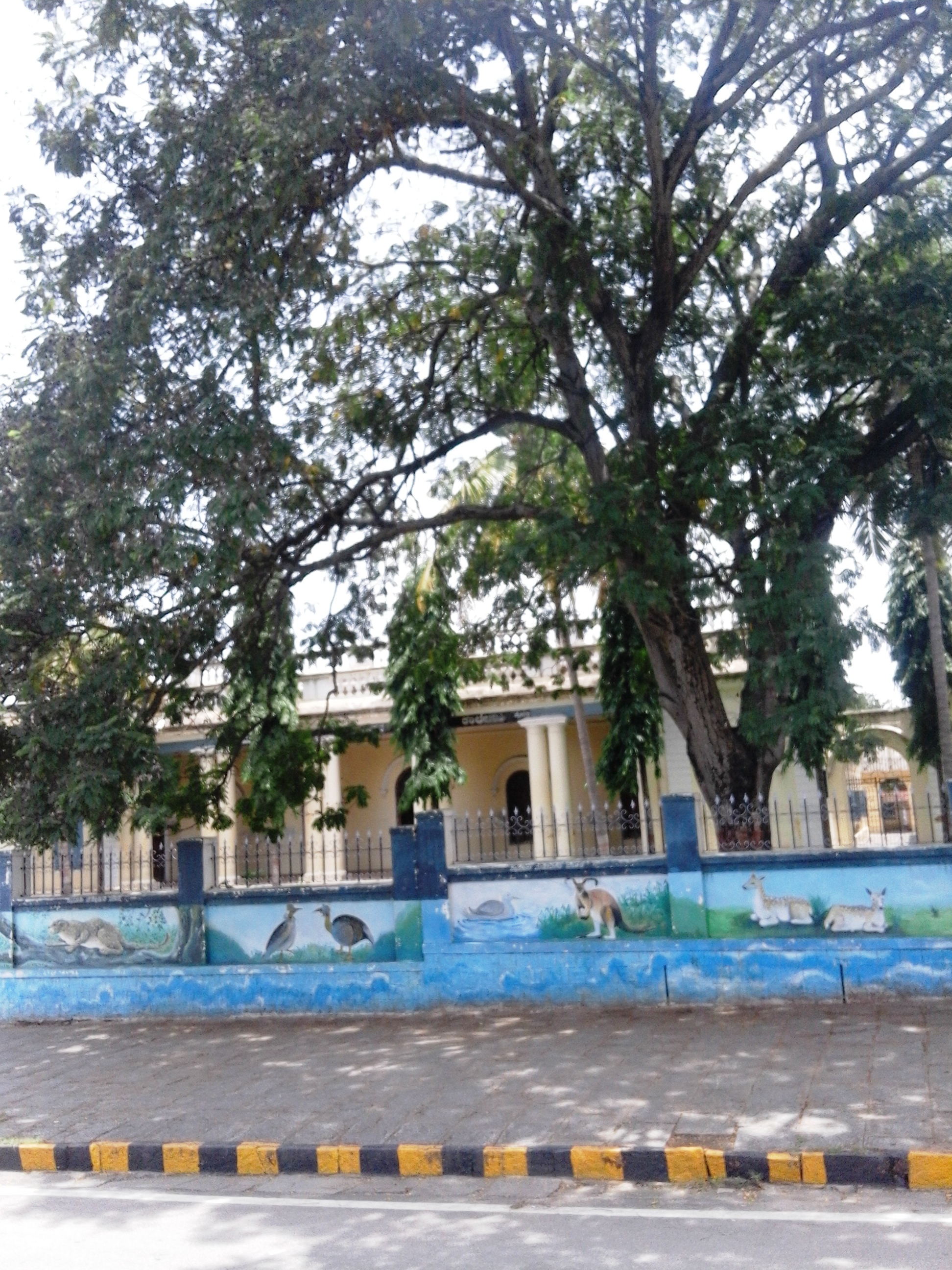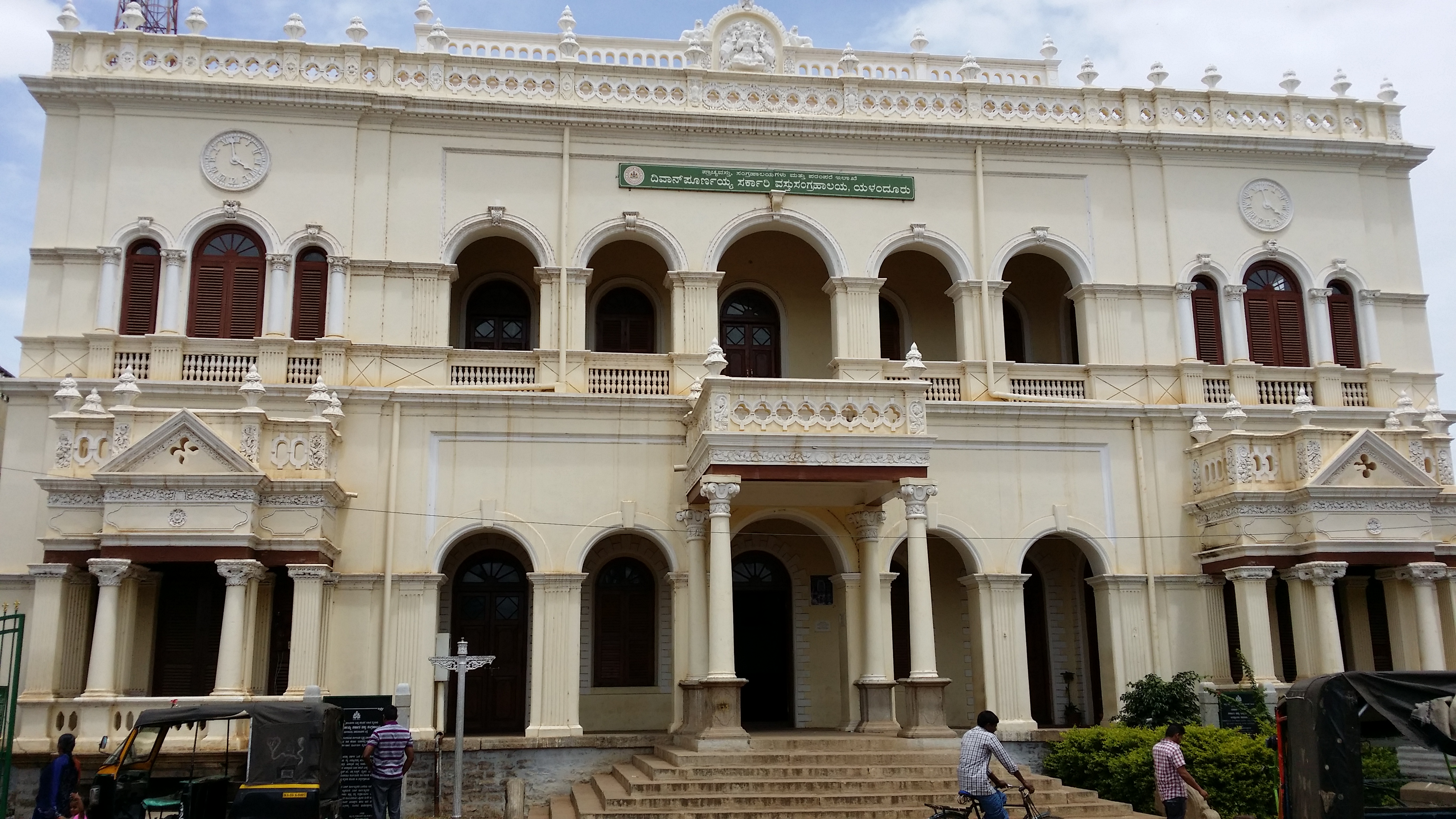|
Agrahara, Mysore
Agrahara is an area of the city of Mysore in the state of Karnataka in India. Famous locations in Agrahara include Mysore Palace as well as several gardens and historic temples. The area is bounded by Albert Victor Road to the North, MG Road to the South, Bengaluru-Nilgiri Road to the East, and Cheluvamba Agrahara Road to the West. The term agrahara or agraharam refers to a grant of land and agricultural income made by royalty to Brahmins in pre-independence South India. Though the Mysuru Agrahara is commonly referred to as a single neighbourhood, it is a composite of multiple adjacent smaller settlements built over time. History Among the first of the settlements built were the Krishna Vilasa Agrahara and the Lakshmivilasa Agrahara, built in 1821. The former had 20 houses and was built opposite the latter. Inscriptions dating from 1821 found within the premises of Prasanna Nanjundeshwara Swamy Temple in Santhepete says that three of the houses were established by the qu ... [...More Info...] [...Related Items...] OR: [Wikipedia] [Google] [Baidu] |
Mysore
Mysore (), officially Mysuru (), is a city in the southern part of the state of Karnataka, India. Mysore city is geographically located between 12° 18′ 26″ north latitude and 76° 38′ 59″ east longitude. It is located at an altitude of above mean sea level. Mysore is situated at the foothills of Chamundi Hills about towards the southwest of Bangalore and spread across an area of . Mysore City Corporation is responsible for the civic administration of the city, which is also the headquarters of Mysore district and Mysore division. It served as the capital city of the Kingdom of Mysore for nearly six centuries from 1399 until 1956. The Kingdom was ruled by the Wadiyar dynasty, with a brief period of interregnum in the late 18th century when Hyder Ali and Tipu Sultan were in power. The Wadiyars were patrons of art and culture. Tipu Sultan and Hyder Ali also contributed significantly to the cultural and economic growth of the city and the state by planting mulber ... [...More Info...] [...Related Items...] OR: [Wikipedia] [Google] [Baidu] |
Agrahara Circle
Agrahara Circle, officially known as N. Madhava Rao Circle, is a street circle and a suburb in the southern Indian city of Mysore in Karnataka. History An Inscription dating back to 1821 located within the premises of Prasanna Nanjundeshwara Swamy Temple at Santhe Pete says that the Agraharas were first established by Maharani Devajammanni, the queen of Maharaja Krishnaraja Wadiyar I and adoptive mother of Maharaja Krishnaraja Wadiyar II, by constructing 21 houses to the west of Mysore Fort, on the right side of the royal stables. Etymology Agrahara Circle is named after the Sir N. Madhava Rao, the dewan of Mysore and prime minister to Maharaja Jayachamaraja Wadiyar. He managed food shortage crisis in the Kingdom faced during the Second World War. During his tenure, the Legislative Council and the Mysore Representative Assembly were combined to form the new Mysore Legislative Council. The first election to the new Council was conducted in February 1941. His son, N. ... [...More Info...] [...Related Items...] OR: [Wikipedia] [Google] [Baidu] |
Chamarajapuram Railway Station
Chamarajapuram is a railway station on Mysore–Chamarajanagar branch line. The station is located in Chamarajapuram, Mysore district, Karnataka Karnataka (; ISO: , , also known as Karunāḍu) is a state in the southwestern region of India. It was formed on 1 November 1956, with the passage of the States Reorganisation Act. Originally known as Mysore State , it was renamed ''Karnat ... state, India. Location Chamarajapuram railway station is located near Ballal Circle in K. G. Koppal, Mysore. History The gauge-conversion work of the stretch was completed at a cost of . There are six trains running forward and backward in this route. Five of them are slow-moving passenger trains. References Railway stations in Mysore district Mysore South {{Karnataka-railstation-stub ... [...More Info...] [...Related Items...] OR: [Wikipedia] [Google] [Baidu] |
Krishnaraja Boulevard
Krishnaraja Boulevard is an important street of Mysore city in Karnataka state of India. Location Krishnaraja Boulevard is located on the southern side of Mysore between Saraswathipuram and Ballal Circle. History Krishnaraja Boulevard is considered as one of the historic streets of Mysore city. It is maintained with grills on the median and planted with flowering trees on either sides. Diminishing Glamour Recently the glamour road has been neglected by the civic authorities and people have started using it as a parking space for vehicles. Historic Buildings This double road is dotted with many historic buildings like the Oriental Library, Maharajas College and the Deputy Commissioner Office, the District Court Complex, Urs Boarding School, College of Architecture and Yuvarajas College. The main office of the Mysore University otherwise known as the Crawford Hall is also located here. Length The boulevard is about one km long beginning from the underbridge junction near ... [...More Info...] [...Related Items...] OR: [Wikipedia] [Google] [Baidu] |
Nanju Malige
Nanju Malige is a market on the southern side of Mysore city in Karnataka state, India. Location Nanju Malige Market is located in Lakshmipura area of Mysore city. Nanju Malige is located very close to Chamundipuram Post Office There is a post office at Nanju Malige and the PIN code is 570004. Economy Nanju Malige is one of the biggest market of flowers, fruits and vegetables in Mysore. Cane goods are also popular here. There are many banks and commercial establishments in this area. Education Gopalaswamy Shishuvihara group of institutions is the biggest educational organization in this area. Image gallery File:Nanjumallige.Gopalaswamy College.jpg, Gopalaswamy College File:Nanjumallige.Double Park.jpg, Double Park File:Nanjumallige. JSS Hostel.jpg, JSS Hostel File:Nanjumallige market.jpg, Cane Market See also * Mysore South * Gurur * Vidyaranyapuram * Jayaprakash Nagar Mysore * Ashokapuram, Mysore * Mananthavady Road Mananthavady Road is an agricultural suburb of ... [...More Info...] [...Related Items...] OR: [Wikipedia] [Google] [Baidu] |
Mahatma Gandhi
Mohandas Karamchand Gandhi (; ; 2 October 1869 – 30 January 1948), popularly known as Mahatma Gandhi, was an Indian lawyer, anti-colonial nationalist Quote: "... marks Gandhi as a hybrid cosmopolitan figure who transformed ... anti-colonial nationalist politics in the twentieth-century in ways that neither indigenous nor westernized Indian nationalists could." and political ethicist Quote: "Gandhi staked his reputation as an original political thinker on this specific issue. Hitherto, violence had been used in the name of political rights, such as in street riots, regicide, or armed revolutions. Gandhi believes there is a better way of securing political rights, that of nonviolence, and that this new way marks an advance in political ethics." who employed nonviolent resistance to lead the successful campaign for India's independence from British rule, and to later inspire movements for civil rights and freedom across the world. The honorific ''Mahātmā'' (Sanskrit ... [...More Info...] [...Related Items...] OR: [Wikipedia] [Google] [Baidu] |
Maharaja's Sanskrit College, Mysore
Srimanmaharaja Samskrita Graduation and Post Graduation Center is an educational organization in Mysore, Karnataka, India. History Sanskrit College, Mysore was established by Krishnaraja Wadiyar III, Krishnaraja Wodeyar III, maharaja of Mysore. After his death, the next king Chamaraja Wodeyar formally opened a Sanskrit School in 1876. Curriculum The colleges offers courses in Vedas, Veda, Agama (Hinduism), Agama and Shastra in traditional methods. The campus contains one of the oldest collection of Sanskrit manuscripts. The courses in the college vary from two years to 13 years. The minimum age for enrolment is eight years. Alumni Notable alumni include Mysore Vasudevachar, Mysore M. Vasudevacharya, Dr. S.Radhakrishnan, Prof. S.Hiriyanna, Maharaja Jayachamaraja Wodeyar and Naveenam Venkatesha Sastry. Courses offered * Sanskrit Prathama. Three Years * Kavya. Two years * Sahithya. Three years * Vyākaraṇa, Vyakarana, Nyaya, Meemaamsa, Dharmaśāstra, Dharma Sastra, Vishis ... [...More Info...] [...Related Items...] OR: [Wikipedia] [Google] [Baidu] |
Purnaiah
Purnaiah (Purniya) (1746 – 27 March 1812), aka Krishnacharya Purniya or Mir Miran Purniya was an Indian Administrator and statesman and the 1st Diwan of Mysore. He has the rare distinction of governing under a sultan and a maharaja, Tipu and Krishnaraja Wadiyar III. He advised the monarchs of the Mysore kingdom from 1782 to 1811. He was known for his skill with accounts, prodigious memory and proficiency in several languages. He was also a wartime military commander while serving under Tipu Sultan. After Tipu Sultan's defeat, he served as the Diwan of Krishnaraja Wadiyar III. Krishnaraja was educated and trained by Purniah in his early years. Early years and rise Purniah came from an orthodox Deshastha Madhva Brahmin family. He was born in 1746 CE. He lost his father at the age of eleven and had to seek employment to support his family. He started writing accounts at a trader's shop. This grocer had close contact with a rich merchant, Annadana Shetty, who supplied lar ... [...More Info...] [...Related Items...] OR: [Wikipedia] [Google] [Baidu] |
Choultry
Choultry is a resting place, an inn or caravansary for travelers, pilgrims or visitors to a site, typically linked to Buddhist, Jain and Hindu temples. They are also referred to as .''The Stanford Dictionary of Anglicised Words and Phrases Edited for the Syndics of the University Press'' by Charles Augustus Maude Fennell, , pages 244, 235, 242, 781, Quote: "Here pilgrims could rest, or look at the processions, or buy house-idols, lamps, rosaries or various souvenirs. These mandapas (or chavadi, choultry) are of two types: (...)" This term is ... [...More Info...] [...Related Items...] OR: [Wikipedia] [Google] [Baidu] |
Constitution Of India
The Constitution of India (IAST: ) is the supreme law of India. The document lays down the framework that demarcates fundamental political code, structure, procedures, powers, and duties of government institutions and sets out fundamental rights, directive principles, and the duties of citizens. It is the longest written national constitution in the world. It imparts constitutional supremacy (not parliamentary supremacy, since it was created by a constituent assembly rather than Parliament) and was adopted by its people with a declaration in its preamble. Parliament cannot override the constitution. It was adopted by the Constituent Assembly of India on 26 November 1949 and became effective on 26 January 1950. The constitution replaced the Government of India Act 1935 as the country's fundamental governing document, and the Dominion of India became the Republic of India. To ensure constitutional autochthony, its framers repealed prior acts of the British parliament in A ... [...More Info...] [...Related Items...] OR: [Wikipedia] [Google] [Baidu] |
Constituent Assembly Of India
The Constituent Assembly of India was elected to frame the Constitution of India. It was elected by the 'Provincial Assembly'. Following India's independence from the British rule in 1947, its members served as the nation's first Parliament as the 'Provisional Parliament of India'. The idea for a Constituent Assembly was proposed in Dec 1934 by M. N. Roy, a pioneer of the Communist movement in India and an advocate of radical democracy. It became an official demand of the Indian National Congress in 1935. The Indian National Congress held its session at Lucknow in April 1936 presided by Pt. Jawahar Lal Nehru. The official demand for Constituent Assembly was raised and Government of India Act, 1935 was rejected as it imposed the Constitution which was against the will of the Indians. C. Rajagopalachari voiced the demand for a Constituent Assembly on 15 November 1939 based on adult franchise, and was accepted by the British in August 1940. On 8 August 1940, a statement was mad ... [...More Info...] [...Related Items...] OR: [Wikipedia] [Google] [Baidu] |






%2C_Binjaveram_Tinnevelly_district%2C_Tamil_Nadu_India.jpg)
